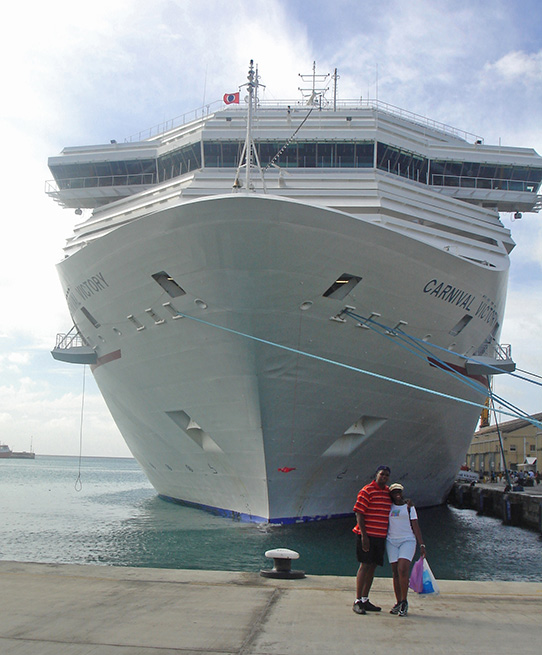
Cruise ship ported in Bridgetown, Barbados
Barbados Transportation
Grantley Adams International Airport
Grantley Adams is the 9th busiest airport in the Caribbean, offering direct service to several destinations in the United States, Canada, Central America, South America and Europe. Check with your preferred airline or Grantley Adams International Airport for the best options to reach Barbados.
Located in Christ Church District, the airport has a museum where you can explore inside a British Airways supersonic plane. That lets you experience the luxury of historic Concorde flights, without the 1400 mph speed of course.
Roadways
As a former British colony, Barbados was heavily influenced by the English culture, customs and transportation infrastructure. Like United Kingdom rules of the road, people in Barbados drive on the left side.
Barbados is 21 miles long and 14 miles wide and has 990 miles of public roads. Barbados highway system radiates from Bridgetown. H1 signifies the first highway that runs north. The numbering continues sequentially in a clockwise direction. The most popular highway throughout the island is the A. B. C. Highway (Adams/Barrow/Cummins).
The most prominent traffic junctions on Barbados roadways are the two-lane roundabouts in Bridgetown. Vehicles in the innermost lane of the roundabout have the right of way. The speed limit on regular roads is 37 mph unless otherwise posted. The speed limit on the ABC Highway and the Spring Garden Highway is 50 mph.
ZR Vans
The ZRs (pronounced “Zed-Rs”), are privately owned mini-vans that run on predetermined routes. They are recognized by their white exterior and maroon stripe down the side. ZRs are independently owned but have a fixed fare of around 2 dollars per person for one way. ZRs are both reliable and often provide entertainment to patrons. They are also slow because they stop frequently to pick up the maximum number of passengers. Therefore ZRs have a reputation for loud music and cramped spacing. But if you’re on vacation, enjoy mingling with locals on their terms.
Taxis
Similar to the United States, taxis provide transportation at a predetermined rate per mile. The driver should tell you the cost when entering. If you miss one, don’t worry. There are plenty on the small island.
Public Buses
Some services run on a direct route to their destinations however, most public transport services require a connection through Bridgetown. Natives predominantly use 200 buses to get around on the island. There are two types of buses, large blue buses and yellow buses. The usually larger blue buses, are government-operated and charge the same small fee as the other services (in Barbados Dollars). Adults pay, but public buses are free for children in school uniforms, students with an institution ID under 18, and senior citizens.
Public buses run on an exact fare system and are unable to give change. Don’t leave your hotel without extra cash in small denominations.
There are also privately operated Minibuses that are yellow with a blue stripe. They operate mainly on the west and south coastline. The most popular routes are Bridgetown–Speightstown and Bridgetown–Sam Lord’s Castle. They charge about $2.50 and do provide change.
Car Rental
For Americans comfortable driving on the opposite side of the road, car rental is provided through rental agencies. They offer a variety of vehicles ranging from small open-top cars to luxury cars to vans. Foreign drivers must purchase a temporary driver’s license and present a valid international driving license.
Waterways
Barbados also provides ports for large cruise ships and transportation of goods into and out of the country. The main ports reside in Bridgetown, Saint Michael (Deep Water Harbour), and in Speightstown, St. Peter (the Port Charles Marina). Large cruise ships dock at the Deep Water Harbour at the southwestern end of the island.
Boating
Boating to and from Barbados requires following all International and local laws. If arriving in Barbados it is important to remember that you must enter an approved port of entry, which means stopping by the Harbour-master first at Bridgetown. National law protects the coral reefs. Consequently, eco-friendly boaters should not drop anchor outside of areas approved by Barbados government in order to protect the corals and island marine life that depend on them.
